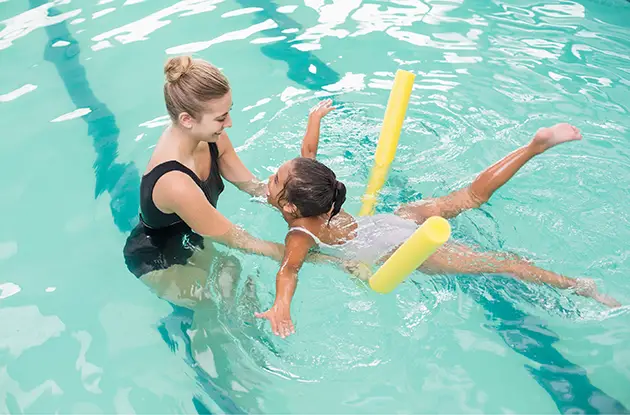A 20-month-old child wanders off unattended from his pregnant mother and falls into a cold swimming pool. Luckily, he had just completed a six-week water safety course: He immediately bopped to the surface and took a gulp of air, allowing enough time for him to be reached and rescued. Keri Tom, owner of and instructor at
Fin2Swim Infant Aquatics, a national swimming school with locations in Bergen, Rockland, Westchester, and Suffolk counties, offers this recollection as she discusses the importance of teaching kids to swim. Thanks to this boy’s early swim lessons, he made it to safety unharmed, if a little shaken up.
Unfortunately, incidents like this one are not rare, and plenty of young students fall in the pool every year, Tom says.
Water Safety First, Always
The story illustrates the primary benefit of children learning to swim at as young an age as possible—even as young as 6 months old: safety. You can’t have fun in the water without appreciable safety skills. Otherwise, she says, “you’re teaching kids to have fun in an extremely dangerous environment, and that’s just a recipe for disaster.”
One of the biggest challenges of learning to swim is fear of the water. While it’s a natural and healthy fear, Tom says, it’s one of the biggest obstacles for instructors of small children. However, an experienced swim instructor can capitalize on a child’s reluctance, and build upon it by teaching solid water-safety practices: “I would rather have a child who is afraid of the water than an overly confident child, because that’s a smart child who knows that they don’t know how to swim,” Tom says.
So how do you eliminate that fear? Step by step.
A good instructor will never ask a child to do something that she is not already familiar with. “She already has the answer before we ask the question,” Tom says.
Katherine Palladino, the aquatics director at Pace University, an American Red Cross Water Safety Instructor, and president of Westchester and Fairfield Swimming and Lifeguarding, has a similar approach when tackling fear in young children. According to Palladino, the best swim instructors are patient, friendly, and build confidence in young children. By being warm and welcoming, “you are instilling trust between child and teacher, and suddenly the skill that the child was afraid of diminishes because it becomes a positive experience instead.”
The American Red Cross Water Safety curriculum is infused with safety lessons throughout all the stages of learning. Older students learn the basic fundamentals of CPR, while young children learn Check, Call, and Care, which outlines how to get help in an emergency situation, how to recognize when someone is struggling in the water, how can you tell if a person is possibly drowning, and how a child can help a person in distress without becoming a victim himself.
Conquering Fear of the Water
Besides water safety and swimming competence, children who begin to swim at a young age have many fewer inhibitions. “The later people start to learn, the more instilled a fear may be,” Palladino says. If you start your kids young enough, swimming is a natural, innate physical movement. On the other hand, the longer you wait, the less natural it becomes. As with walking, riding a bike, or any muscular learning skill, once a person can swim, it’s impossible to forget—that child has a skill for her lifetime.
The youngest a child can begin water lessons is 6 months old, but Palladino recommends that children start learning the fundamentals of swimming by 4 or 5 years old. Being “water-safe” or “water-competent” means a child can swim comfortably on his front and back and can complete a 180-degree turn in the water, or can turn and swim to safety if need be. In many programs, including Fin2Swim, a child must pass a fully clothed survival scenario. (It’s important to remember that water-competence never means that a child can be left unsupervised in water!)
In truth, any age is a great time to learn to swim. Whether boating, fishing, or just playing on the beach, many children’s summer activities occur on or near water. Not only is it vitally important that your child knows how to stay safe in these environments, but being able to swim can be socially advantageous for a child. Whether he’s enrolled in camp, or she’s invited to a pool party, knowing how to be safe in the water opens up a whole new world of fun for children.
RELATED: Find Swim Classes for Kids Near You






.jpg)




